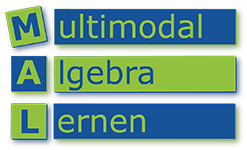Hier finden Sie die Publikationen, die im Rahmen der Forschung des MAL-Projektes entstanden sind.
Januar 2019 – Artikel in ZDM
Evidence and argument in a proof based teaching theory
David Reid & Estela Vallejo
In this article we outline the role evidence and argument plays in the construction of a framing theory for Proof Based Teaching of basic operations on natural numbers and integers, which uses tiles to physically represent numbers. We adopt Mariotti’s characterization of a mathematical theorem as a triple of statement, proof and theory, and elaborate a theory in which the statement “The product of two negative integers is a positive integer” can be proved. This theory is described in terms of a ‘toolbox’ of accepted statements, and acceptable forms of argumentation and expression. We discuss what counts as mathematical evidence in this theory and how that evidence is used in mathematical arguments that support the theory.
Oktober 2018 – Workshop CHI Play 2018
Exploring Tangible Algebra Learning in Schools
Dmitry Alexandrovsky, Tanja Döring, Stefan Bollen, Anke Reinschluessel, Angelika Bikner-Ahsbahs, Rainer Malaka
Interactive Systems for learning offer great potentials for the use in school classes as they allow supporting teachers in addressing students at different knowledge levels at the same time, the systems can provide valuable and individual feedback and are motivating and entertaining for the students using it due to gamification elements. Nevertheless, developing learning systems for schools is demanding, as many different stakeholders need to be involved. In this workshop paper, we report from a transdisciplinary research project with computer scientists, mathematics educators and a textbook publisher, in which we investigate the potentials of using tangible user interfaces for algebra learning. In this paper, we particularly present insights from a comparative study in school, in which 22 students (grade 7) used either a touch-based or a tangible-based algebra learning system on a tablet. Our results show that both system versions generally work well and that the tangible system received higher user experience.
Q3/2018 – ICOM Special Issue
Multimodal Algebra Learning: From Math Manipulatives to Tangible User Interfaces
Anke Reinschluessel, Dmitry Alexandrovsky, Tanja Döring, Angelie Kraft, Maike Braukmüller, Thomas Janßen, David Reid, Estela Vallejo, Angelika Bikner-Ahsbahs, and Rainer Malaka
While manipulatives have played an important role in children’s mathematics development for decades, employing tangible objects together with digital systems in the classroom has been rarely explored yet. In a transdisciplinary research project with computer scientists, mathematics educators and a textbook publisher, we investigate the potentials of using tangible user interfaces for algebra learning and develop as well as evaluate a scalable system for different use cases. In this paper, we present design implications for tangible user interfaces for algebra learning that were derived from a comprehensive field study in a grade 9 classroom and an expert study with textbook authors, who also are teachers. Furthermore, we present and discuss the resulting system design.
Link: ICOM Special Issue: Tangible Interaction and its Applications
April 2018 – Workshop Paper auf der CHI 2018
Beyond Math Manipulatives: Smart Tangible Objects for Algebra Learning
Anke V. Reinschluessel, Tanja Döring, Dmitry Alexandrovsky, Danny Thieme, Rainer Malaka
This workshop position paper presents ongoing research on using smart tangible objects for algebra learning. While mathematical manipulatives have played an important role in children’s mathematics development for decades, employing tangible objects in the classroom has been rarely explored yet. In our work, we investigate the potentials of using smart objects for algebra learning. Our smart tiles are based on traditional algebra tiles, passive mathematical manipulatives used in many schools in Northern America, and we currently extend these by 1.) multimodal input and output capabilities, 2.) dynamic constraints and 3.) adaptivity and feedback. In this paper, we give an overview on the overall system concept, the interaction with the tangible objects and their current design, as well as on the potentials of actuated smart objects for future interaction.
August 2017 – Poster auf der ICTMT13
Boundary objects in interdisciplinary research on multimodal algebra learning
Thomas Janßen und Tanja Döring
We present a set of boundary objects we indentified in an ongoing interdisciplinary research and development project, where mathematics didacticians collaborate with human-computer interaction experts to develop digitally enhanced versions of manipulatives for algebra learning.
Link: Proceedings der ICTMT13 mit der Posterbeschreibung (S. 447 f.)
März 2017 – Vortrag auf der Jahrestagung der GDM
Multimodal algebraischen Struktursinn erwerben
Thomas Janßen
Link: Artikel in den Beiträgen zum Mathematikunterricht
Februar 2017 – Poster auf der CERME10
Using tangible technology to multimodally support algebra learning: The MAL project
Thomas Janßen, David Reid, Angelika Bikner-Ahsbahs, Anke Reinschlüssel, Tanja Döring, Dmitry Alexandrovsky, Rainer Malaka und Estela Vallejo
An interdisciplinary project investigating the possibilities and challenges of making use of so called smart objects in algebra education is presented. As the project is still in its initial phase, the focus is on the theoretical foundations, design ideas, and questions that are to be pursued.
Link: CERME10 Posterbeschreibung
In this article we outline the role evidence and argument plays in the construction of a framing theory for Proof Based Teaching of basic operations on natural numbers and integers, which uses tiles to physically represent numbers. We adopt Mariotti’s characterization of a mathematical theorem as a triple of statement, proof and theory, and elaborate a theory in which the statement “The product of two negative integers is a positive integer” can be proved. This theory is described in terms of a ‘toolbox’ of accepted statements, and acceptable forms of argumentation and expression. We discuss what counts as mathematical evidence in this theory and how that evidence is used in mathematical arguments that support the theory.
